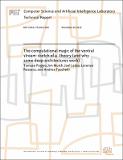| dc.contributor.advisor | Tomaso Poggio | |
| dc.contributor.author | Poggio, Tomaso | en_US |
| dc.contributor.author | Mutch, Jim | en_US |
| dc.contributor.author | Leibo, Joel | en_US |
| dc.contributor.author | Rosasco, Lorenzo | en_US |
| dc.contributor.author | Tacchetti, Andrea | en_US |
| dc.contributor.other | Center for Biological and Computational Learning (CBCL) | en_US |
| dc.date.accessioned | 2013-01-10T21:15:06Z | |
| dc.date.available | 2013-01-10T21:15:06Z | |
| dc.date.issued | 2012-12-29 | |
| dc.identifier.uri | http://hdl.handle.net/1721.1/76248 | |
| dc.description.abstract | This paper explores the theoretical consequences of a simple assumption: the computational goal of the feedforward path in the ventral stream -- from V1, V2, V4 and to IT -- is to discount image transformations, after learning them during development. | en_US |
| dc.format.extent | 120 p. | en_US |
| dc.relation.ispartofseries | MIT-CSAIL-TR-2012-035 | en_US |
| dc.rights | Creative Commons Attribution-NonCommercial-NoDerivs 3.0 Unported | en |
| dc.rights.uri | http://creativecommons.org/licenses/by-nc-nd/3.0/ | |
| dc.subject | visual cortex | en_US |
| dc.subject | ventral stream | en_US |
| dc.subject | symmetries principles in sensory perception | en_US |
| dc.subject | visual recognition | en_US |
| dc.subject | invariances of sensory perception | en_US |
| dc.subject | learning to learn invariants in the visual world | en_US |
| dc.title | The computational magic of the ventral stream: sketch of a theory (and why some deep architectures work). | en_US |
